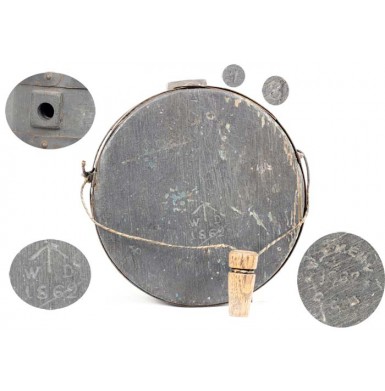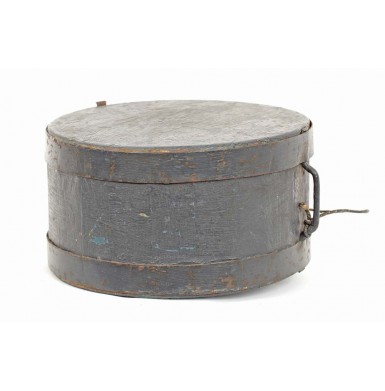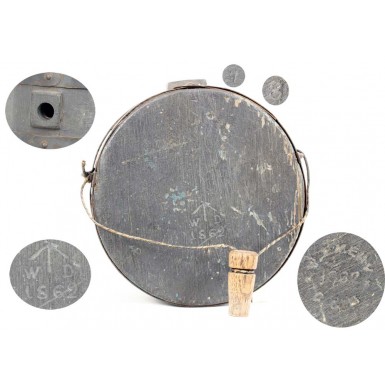This is a very nice example of a fairly scarce British military wooden canteen, or “waterbottle” as the British referred them to during the 19th century. The history of the British military canteen is interesting in that it appears to “devolve” rather than “evolve” with time. The standard British military “waterbottle” of the 18th century, from before the Seven Years War (French & Indian War) through the Revolutionary War and into the dawn of the 19th century, was a metal one made of heavy gauge iron tin plate. The canteen held about a quart of water and was either kidney shaped or crescent shaped. It was suspended from a hemp cord that passed through tin thimbles on the opposing edges of the canteen, and typically used a wooden stopper to keep it closed. Sometime during the end of the 18th century a wooden canteen was taken into British service, and although some of the older tinplated canteens continued to see use into the early 19th century, by the War of 1812, most British soldiers were carrying a wooden canteen in the field. According to author and researcher Pierre Turner, the British military use of a wooden canteen is first depicted in a 1794 sketch by C. Hamilton Smith, of a British Light Dragoon, entitled The Death of Major-General Mansel at Beaumont. Turner also references an 1813 dated order for a large number of wooden canteens that reads in part: “20,000 wooden canteens to contain 3 pints”.of the best Riga oak.” This indicates that the volume of the new wooden canteens increased by 50% from 1 quart (2 pints) to 1.5 quarts (3 pints), an increase probably appreciated by the soldiers in the field. The canteen adopted was made of two pieces of carved oak that served as end pieces, with oak staves between them, secured by a pair of riveted hoops. A pair of iron wire sling guides were also secured by the hoops at the roughly 10 O’clock and 2 O’clock positions, through which a leather strap typically about 5” 8” long by 1” wide would pass. The strap had a simple roller buckle at its end to adjust the overall length of the sling. The canteen had a square wooden mouthpiece and a turned pine wood stopper that was secured to each of the iron sling guides with a length of twine. The canteens varied slightly in outer measurements, but were typically about 7” in diameter and about 3 ““ deep. The canteen was usually painted a light or sky blue color, but this was sometimes over-painted in the field at the direction of the regimental commander. At least one example in the collection of the Bonmann Museum of Cultural History in Celle, Germany (lower Saxony) has a British military canteen identified to the King’s German Legion (c1803-1815) that has been painted black with yellow regimental embellishments and identification. However, traces of the original blue paint do show through the worn areas of black. Other extant examples of overpainted canteens exist, suggesting it was not uncommon to make the light blue canteens less prominent in the field. It is also interesting to note that the canteen was not considered an accouterment for the British soldier, like his cartridge box, bayonet scabbard, etc., but rather a piece of camp equipage. The British military classified the haversack in the same way. This meant that canteens and haversacks were only issued when the regiment was going into the field for active campaigning. A great period account, written Lt. Colonel Ainslie of the 21st Regiment of Foot, on board a ship in August of 1854 discusses both the painting of canteens and their issue:
“Today we have been issuing the canteens and haversacks to the men, previous to landing. The former stink most infernally of paint which is not yet dry on them.”
Colonel Ainslie’s Royal Scot’s Fusiliers were about to land in the Crimea, where they would participate in the battles of Alma and Inkerman as part of Sir George Cathcart’s Division.
This style of wooden canteen remained in service, with only some very minor changes that are almost imperceptible to the casual observer, from the end of the 18th century until 1874, when the list of pattern changes specified the adoption of the Pattern 1874 “Italian” waterbottle. This was also a wooden canteen, but was flask shaped with a threaded stopper. It would remain in use as the “Waterbottle, Italian” and “Waterbottle, Italian Mark II” until the adoption of a metal, oblate spheroid canteen in 1888 that was quite similar to the US M-1858 canteen of the Civil War era. The most dramatic changes to the British wooden canteen during its 80+ years of service were a change in markings and a change in construction. In 1855 the Board of Ordnance was designated the War Department. Prior to that name change, all British military arms and equipage were marked with a “Broad Arrow” to denote Crown ownership and the letters “BO” for Board of Ordnance. After the name change, all items previously marked “BO” were marked “WD” for War Department. The change in construction of the canteen took place in the War Department List of Changes 505, January 6, 1862 and read in part: “Canteens, having the ends of the staves and the chime not projecting beyond the heads.”. To put it simply, the earlier pattern canteens had end pieces (“heads”) ride in a groove in the staves, with the edges of the staves forming a rim (chime) that extended slightly beyond the sides of the canteens. This can easily be observed, as the round ends appear recessed and the space between each stave is visible from the round sides of the canteens. The new pattern canteens had the end pieces slightly enlarged, with the ends of the staves engaging a groove around the inner edge of each side of the canteen. This gave the canteen a more finished look and the edges of the staves were no longer visible from the ends of the canteen. While the change is subtle and not readily noticeable at a quick glance, it improved the quality and consistency of the canteen construction. All canteens produced after the pattern change are typically referred to as Pattern 1862 canteens. While most collectors do not think about canteens being imported into the Confederacy from England during the Civil War, the cargo manifest of one Confederate blockade-runner mentions two cases of British canteens. The blockade-runner Index arrive in Wilmington, NC on February 8, 1864 carrying two cases marked with the letters OB within a rhomboid. These cases, numbered 4114 and 4115, contained British canteens. Unfortunately, the number of the canteens in each case is not indicated. It is typically believed that the canteen, whether the classic “tin drum” or the equally ubiquitous CS wooden canteen, was an item that could be made in sufficient quantity in the south to obviate the need to import any. However, if 2 cases arrived in Wilmington during early 1864, it is probably safe to assume that other cases of canteens arrived in southern ports in the months immediately prior to and after that date.
Offered here is a wonderful, early production, British Pattern 1862 Waterbottle (canteen). The canteen is the classic painted oak, post January of 1862 pattern, with 20 wooden staves approximately 1” wide by about 3 5/8” long, set into a pair of 6 ““ diameter heads. The external dimensions of the canteen are 6 ““ by 3 ““ The wooden spout is not quite square, measuring 11/4” by 1 3/8” and is about 5/16” tall. The spout has a round 11/16” opening to fill the canteen to drink from. The canteen appears to be entirely original, with the exception of the turned wooden stopper and twisted twine that secure the stopper to the iron sling brackets. The stopper is very old and fits very well and I believe it is a period of use replacement. The entire canteen has been overpainted a smoky gray color during the period of use, and traces of the original British light blue paint can be seen along the edges, under the iron hoops and where the paint has chipped and worn from carry and use. The overpainting has made the markings on the canteen somewhat less distinct, but they are still fairly legible. One side is deeply stamped with the British military (BROAD ARROW), flanked by the letters W and D, over the date 1862. The numbers 186 are part of a gang stamp and the number 2 is separate. A typical system to use when marking items that were inspected. This allowed the primary stamp to be used for many years, and only the last number having to be changed on a yearly basis. The other side of the canteen bears a roundel style cartouched makers mark around the date 1862. The mark appears to read W. EMERY & CO. William Emery & Company was listed in 19th century English directories as “chandelier, manufacturers & general brass founders”. The term “chandelier” was an archaic one that originally meant a maker and seller of candles, but by the 18th century had come to be “chandler”, one who supplies ships, particularly of the Royal Navy, and by the end of the 18th century applied to any general sellers of supplies, equipment and victuals to the British military. Clearly in 1862 Emery received a British military contract for canteens and his were certainly some of the first of the newly described pattern to be procured. The side-pieces of the canteen are stamp numbered 7 and 8. This suggests that the side-pieces were carved as pairs in groups (probably numbered 1-10) and were then partnered up during the assembly process in numerical order; 1&2, 3&4, etc. Whether this canteen remained in British military service and was over painted at the order of a regimental commander, was part of the consignment of canteens sold to the Confederacy and repainted in the south by a soldier who wanted to be less conspicuous, or whether it was painted its current dark gray after it had completed its military service life is something that we will never be able to know. Typically the presence of any type of British military ownership mark, like the “Broad Arrow / WD” would suggest that the item could not have come here for use by either side. This is particularly true of weapons (although a handful of unique exceptions exist), however, it appears much less true of non-ordnance material. British made and marked military items with Confederate provenance exist in museum and private collections, including a War Department marked “British Issue Shirt” at the Museum of the Confederacy and at least a couple of British military marked blankets with southern identifications. This suggests that the non-combat equipment of the British military was sometimes sold out of stores to Confederate buyers willing to pay premium prices.The canteen remains in very crisp and solid condition, with no breaks, cracks or damaged noted. All of the original iron hardware is intact and in very nice condition as it has been protected by the layer of added paint. There is some light surface oxidation visible along the edges of the iron hoops and the iron sling brackets, as well as some of the area of iron that have become exposed to the atmosphere due to the paint flaking and chipping. All of the metal parts remain strong and completely serviceable with no undue wear or damage noted. There is some minor visible separation between some of the 20 staves that encircle the canteen, but that is to be expected. This type of wooden canteen is made on the principle of “wet cooperage” and relies upon the natural swelling of the wood when it is wet to expand the staves and make the canteen relatively water tight. A good soaking for a couple of days would probably swell it up tight enough for use today. As noted, the stopper appears to be a period replacement and it shows good age and wear. It appears that it is made of walnut and shows a very tight, short grain. The twine that secures the stopper has strong traces of the dark gray paint, so it was on the canteen when it was painted. This suggests the painting was done in the field, while on campaign, but whether it was done by a British Regular or Johnny Reb cannot be determined.
Overall, this is a really nice example of a scarce British Military Waterbottle (Canteen) in a very nice state of preservation. Wood canteens do not tend to survive well with continued campaigning and service, and while this one shows good age, wear and real world use, it shows no abuse. While I certainly cannot claim that this is one of the wooden canteens imported during the Civil War by the Confederacy, it is safe to say that this is of the correct style and pattern that were brought into the south. It is a good “representative example”, without a “Confederate” price. Whether you collect 19th century British military items, military canteens, or are looking for a good example of the kinds of items that came through the blockade to the south, this would be a great addition to your collection. This canteen displays well, is well marked and is in very solid condition.
SOLD








